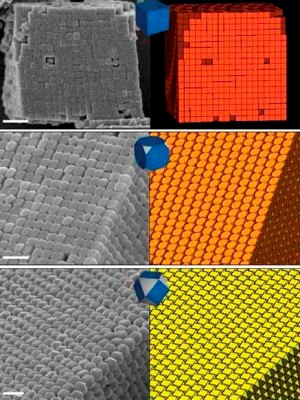A research team led by Peidong Yang, who is a Chemist at the Materials Sciences Division of the Lawrence Berkeley National Laboratory (Berkeley Lab) of the U.S. Department of Energy (DOE), has developed high-density three-dimensional supercrystals by stimulating silver nanocrystals having polyhedral shapes to self assemble, facilitating the production of novel plasmonic materials.
The research team used a gravitational sedimentation process to self-assemble polyhedral-shaped silver nanocrystals into unique large-scale silver supercrystals. The team has published this novel method in the Nature Materials journal under the title ‘Self-assembly of uniform polyhedral silver nanocrystals into densest packings and exotic superlattices.’
 On the left are micrographs of supercrystals of silver polyderal nanocrystals and on the right the corresponding diagrams of their densest known packings for (from top-down) cubes, truncated cubes and cuboctahedra. (Credit: Berkeley Lab)
On the left are micrographs of supercrystals of silver polyderal nanocrystals and on the right the corresponding diagrams of their densest known packings for (from top-down) cubes, truncated cubes and cuboctahedra. (Credit: Berkeley Lab)
The research team has utilized a polyol synthesis process for the production of silver nanocrystals having various shapes such as octahedral, truncated octahedral, cuboctahedra, truncated cubes and cubes, with sizes ranging between 100 and 300 nm. The resulting homogenous polyhedral nanocrystals were then transferred into a solution wherein they self-assembled through gravitational sedimentation to form dense silver supercrystals having a size of around 25 mm2. The team was able to control the dimensions of the supercrystals accurately, as it placed the solution in the reservoirs of microarray channels wherein the self-assembly process took place.
Yang stated that his research team was able to control the particle shape easily and efficiently. In comparison with spherical particle crystal structures, the team’s dense polyhedral supercrystals demonstrate various geometries of voids and gaps, larger particle interfaces and higher packing fractions, which are helpful in identifying their optical and electrical properties, Yang added.
The silver nanocrystals utilized by the research team are superior plasmonic materials for surface-enhanced applications including photocatalysis, nanophotonics and sensing. The fabrication of three-dimensional supercrystals by stacking these nanocrystals makes them suitable as metamaterials having innovative optical properties, paving the way for the advancement of plasmonic technology. The team’s self-assembly method of silver polyhedral nanocrystals is capable of producing scalable nanomaterials with sizes equivalent to that of bulk materials, Yang concluded.